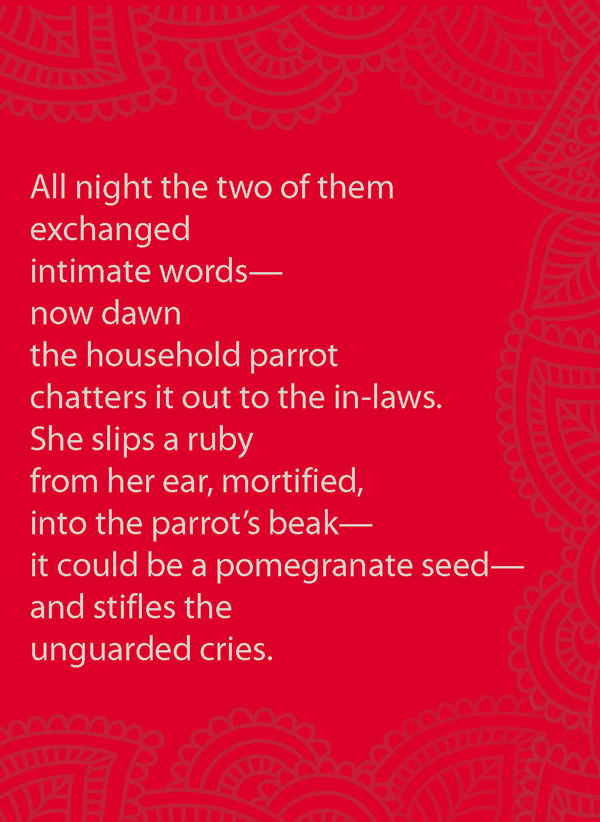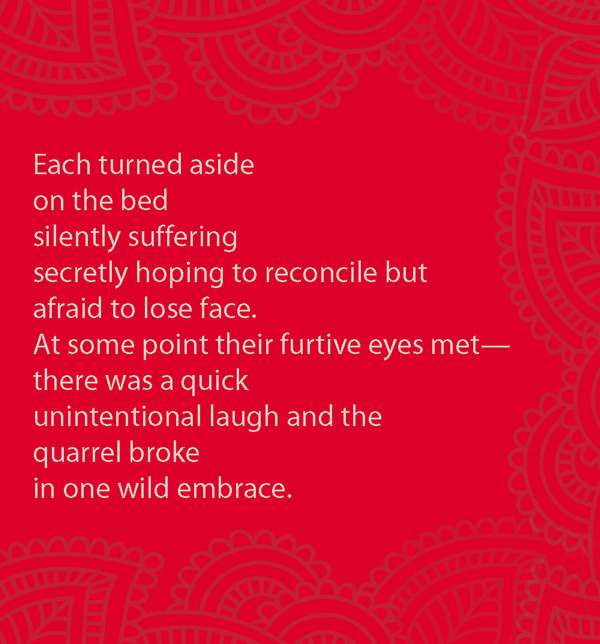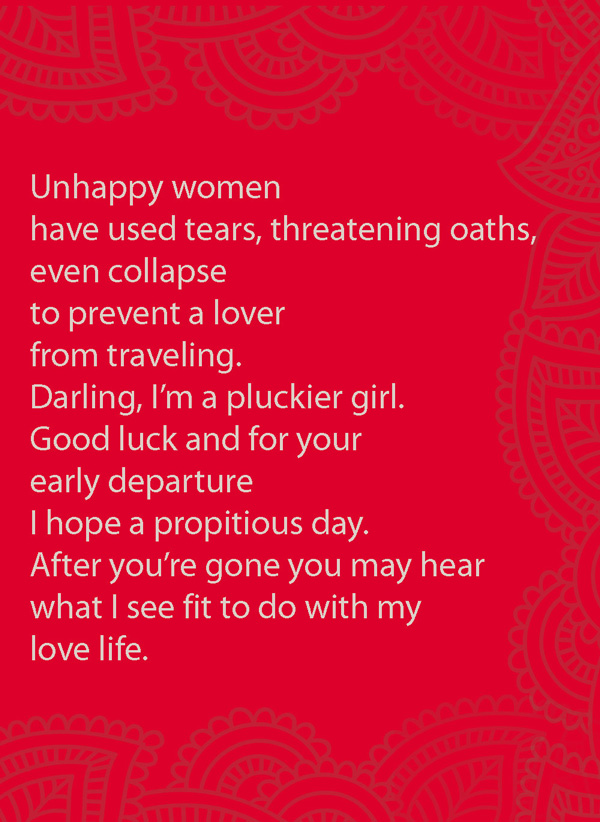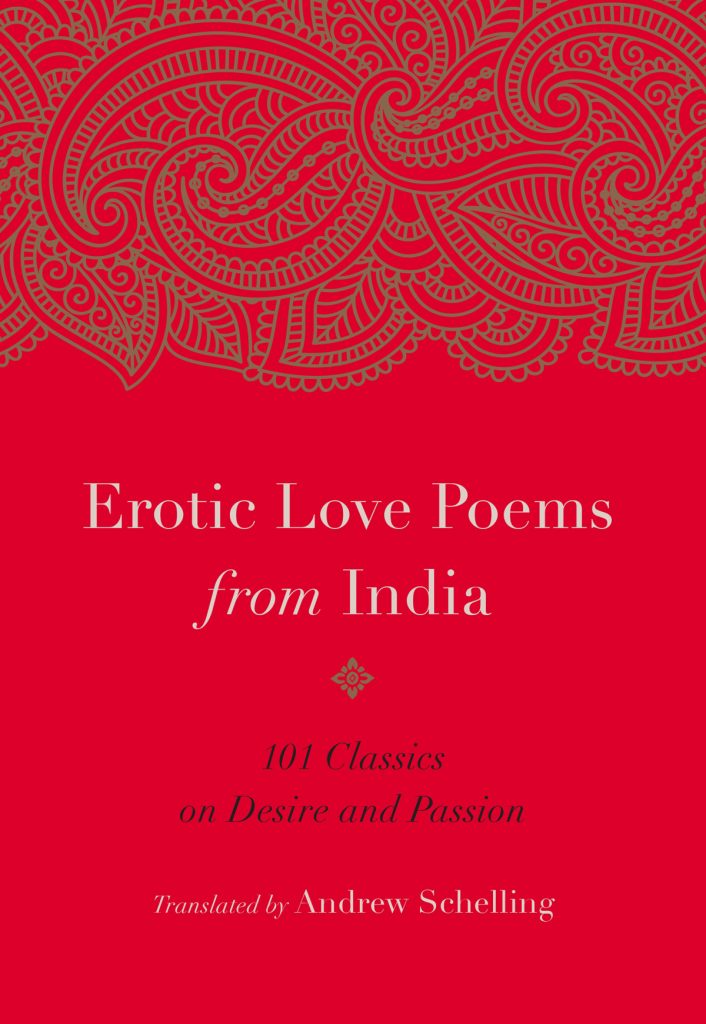Lovers exchange intimacies until dawn. An unfaithful husband begs forgiveness at the feet of his enraged wife. A woman steals away from the threat of her lover’s in-laws. These are only some of the many romantic predicaments found in Erotic Love Poems from India, Andrew Schelling’s translation of the 7th-century Sanskrit text Amarushataka—meaning the “one hundred poems of Amaru,” a legendary king of Kashmir. In addition to being wonderful examples of how virtuosic Indian poetry can be, the collection offers a glimpse into a time and culture where eroticism and spiritual practice were not opposed.
Schelling, a Buddhist poet, essayist, and author, has taught poetry in the Jack Kerouac School of Disembodied Poetics at Naropa University since 1990. This month, his 2004 translation was re-released from Shambhala Publications, offering contemporary readers poetry that is sensual, humorous, and wise. The verses paint complicated and often relatable pictures of the love lives of their protagonists.
Tricycle spoke to Schelling about the history, language, and power of these Indian love poems—poems in which eros and wisdom go hand-in-hand.
Could you tell me a little bit about this translation project?
The Amarushataka is usually [presented as] being slightly over 100 poems. They are seen in India as forming a cycle of love poems that take you through—in a very careful way—a lot of the different emotional territories of love relationships, but they are not linked together by narrative or strict formalism. Each of the poems is meant to stand on its own, and yet the way that they move you through both the sweet joys and bitter pains of love affairs brings you through an entire cycle.

The Amarushataka is such an old collection that there’s no real way to tell what it was like at its outset, exactly how old it is, where it came from, or who composed it. The traditional Indian view was that it was a carefully thought out collection by a single author. However, many of the poems show up in other collections and are attributed to other authors. So modern scholars tend to regard it as an anthology collected by somebody named Amaru, who possibly added some poems to it. But there’s no way to know exactly since we can’t go back to 7th century (or even earlier).
There’s some fascinating lore surrounding authorship of this collection. Could you tell us a bit more about its background?
The traditional account of the authorship is one of those terrific stories that you could only get out of India. The great philosopher Shankara—or Shankaracharya, as he’s sometimes called, who was a great exponent of nondual philosophy—was having a public debate with another philosopher, Mandana Misra. He was beating his opponent when the other philosopher’s wife took the stage of debate and began to press Shankara with philosophical and metaphysical questions couched in the language of erotic love. Shankara, being celibate, didn’t know how to respond. So, he asked for an adjournment. Through his yoga powers, he left his body—entrusting it to his disciples—and entered the corpse of a king named Amaru, a Kashmiri war lord.

Amaru came back to life and Shankara, through Amaru’s body, spent one hundred days studying the scriptures on love—the Kamasutra of Vatsyayana and other commentaries—and then spent every evening with one of Amaru’s harem women. At the end of this intensive learning situation, Shankara dropped Amaru’s body to its fate, returned to his own, took the stage of debate, and vanquished his opponents. The legend says that he composed a poem to memorialize each of the nights he spent in Amaru’s body, and signed the book with Amaru’s name out of gratitude.
It seems like most poems are about ten lines or so. Is this a classic Indian form?
In my translations they are, yes. In the original they’re all four-line poems, but they’re very complicated lines compared to what we’re used to in contemporary American poetry. I think about half of the poems are [written] in a meter that has 19 syllables per line. The old Sanskrit lines are dense, and quite long, and would be impossible to reproduce in contemporary American English without it feeling very labored. I’ve tended to make the lines shorter and tried to have the poems move more swiftly down the page in a style that contemporary readers are used to.
I am curious about the pronouns throughout the book. It seems like some poems are spoken from the man’s perspective, some from the woman’s, and some from that of an unnamed narrator.
Sanskrit is a language that has three genders. You might be familiar with masculine and feminine in French, Italian, Spanish, and so on. Sanskrit actually has three, and one of them is “neuter.” Because of this, poems often do not have pronouns at all. You can tell the gender of the person speaking from nouns and, in some cases, from verbal forms.

But you’re absolutely right—the poems themselves speak from a lot of different perspectives. Sometimes they speak from outside the action of the poem, sometimes intimately from the voice of one person or another, and those speakers may be male or female. They’re meant to be recognizable fairly quickly. However, the fact that they’re spoken by men and women doesn’t really tell us anything about authorship; Sanskrit poetry may have emerged out of an old theatrical tradition, so having poems in the voice of a man or a woman may not be any more than as if you lifted out a soliloquy by, say, Shakespeare’s Juliet. It may be in the voice of a woman, but that doesn’t mean that a woman necessarily wrote it, and vice versa.
Do you think these poems contain spiritual wisdom about desire alone, or is there another layer?
I think you can see it multiple ways. We do know that the poems emerged from India at the same time that tantra was really beginning to develop. There was a lot of exploration of physical love as a pathway to liberation or enlightenment. But there was also a great deal of interest in spiritual texts that could incorporate the experiences of love within them so that everybody would have ways of relating to the teachings.
Related: X-rated Tips from an Ex-Monk
It’s very hard for Western civilization to comprehend this, but I don’t think ancient India had such a hard and fast line between spiritual wisdom and carnal pleasure. Simply look at other forms of Indian art, like the erotic sculpture at the Khajuraho monuments or [the Sun Temple in] Konark, and up into Nepal where erotic sculpture ornaments the most holy temples. In the West, we are so used to making these dichotomies, or these separations between a life of the flesh and sensuality on one hand and spiritual discipline on the other. India didn’t have that separation as far as I can tell. So I’m not sure it is even a distinction that would necessarily hold to the poets.
What do you hope that contemporary readers of the book might learn, or how do you hope they might be affected by its verses?
At the surface level, these are very beautiful poems that seem to capture certain kinds of emotional experiences most of us have had in our lives. I want readers to recognize that India had a very refined and well practiced tradition of love poetry hundreds and even thousands of years ago. Western civilization was not the only one capable of extraordinarily delicate and articulate lyric poetry—or poetry that has metaphysical intention buried in it, is full of figures of speech, and exhibits a highly developed artistic sense.
Related: Translating the Speech of the Gods
Hundreds of years of British colonialism hurt India badly. It hurt India politically and economically, and since colonists tend to disparage the countries that they have conquered, India’s reputation was damaged as well. The West still does not have a great enough understanding of the refinement of Indian art. Many musicians have woken up to the terrific structures of raga music, with its complex modal tones and rhythms, but poetry has lagged behind, because there haven’t been good translations. I hope that my contribution helps bridge that gap.
♦
Poems from Erotic Love Poems from India translated by Andrew Schelling © 2004 by Andrew Schelling. Reprinted in arrangement with Shambhala Publications, Inc. Boulder, CO.
Thank you for subscribing to Tricycle! As a nonprofit, we depend on readers like you to keep Buddhist teachings and practices widely available.
